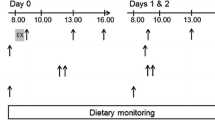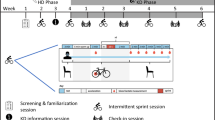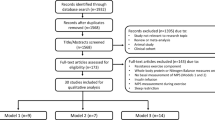Abstract
The effect of nutrient availability on the acute molecular responses following repeated sprint exercise is unknown. The aim of this study was to determine skeletal muscle cellular and protein synthetic responses following repeated sprint exercise with nutrient provision. Eight healthy young male subjects undertook two sprint cycling sessions (10 × 6 s, 0.75 N m torque kg−1, 54 s recovery) with either pre-exercise nutrient (24 g whey, 4.8 g leucine, 50 g maltodextrin) or non-caloric placebo ingestion. Muscle biopsies were taken from vastus lateralis at rest, and after 15 and 240 min post-exercise recovery to determine muscle cell signalling responses and protein synthesis by primed constant infusion of l-[ring-13C6] phenylalanine. Peak and mean power outputs were similar between nutrient and placebo trials. Post-exercise myofibrillar protein synthetic rate was greater with nutrient ingestion compared with placebo (~48%, P < 0.05) but the rate of mitochondrial protein synthesis was similar between treatments. The increased myofibrillar protein synthesis following sprints with nutrient ingestion was associated with coordinated increases in Akt-mTOR-S6K-rpS6 phosphorylation 15 min post-exercise (~200–600%, P < 0.05), while there was no effect on these signalling molecules when exercise was undertaken in the fasted state. For the first time we report a beneficial effect of nutrient provision on anabolic signalling and muscle myofibrillar protein synthesis following repeated sprint exercise. Ingestion of protein/carbohydrate in close proximity to high-intensity sprint exercise provides an environment that increases cell signalling and protein synthesis.






Similar content being viewed by others
References
Anthony JC, Yoshizawa F, Anthony TG, Vary TC, Jefferson LS, Kimball SR (2000) Leucine stimulates translation initiation in skeletal muscle of postabsorptive rats via a rapamycin-sensitive pathway. J Nutr 130(10):2413–2419
Bevington A, Brown J, Walls J (2001) Leucine suppresses acid-induced protein wasting in l6 rat muscle cells. Eur J Clin Invest 31(6):497–503
Bevington A, Brown J, Butler H, Govindji S, Khalid KM, Sheridan K, Walls J (2002) Impaired system a amino acid transport mimics the catabolic effects of acid in l6 cells. Eur J Clin Invest 32(8):590–602
Burgomaster KA, Hughes SC, Heigenhauser GJF, Bradwell SN, Gibala MJ (2005) Six sessions of sprint interval training increases muscle oxidative potential and cycle endurance capacity in humans. J Appl Physiol 98(6):1985–1990. doi:10.1152/japplphysiol.01095.2004
Burgomaster KA, Howarth KR, Phillips SM, Rakobowchuk M, MacDonald MJ, McGee SL, Gibala MJ (2008) Similar metabolic adaptations during exercise after low volume sprint interval and traditional endurance training in humans. J Physiol 586(1):151–160. doi:10.1113/jphysiol.2007.142109
Coffey VG, Zhong Z, Shield A, Canny BJ, Chibalin AV, Zierath JR, Hawley JA (2005) Early signaling responses to divergent exercise stimuli in skeletal muscle from well-trained humans. FASEB J 20(1):190–192
Coffey VG, Jemiolo B, Edge J, Garnham AP, Trappe SW, Hawley JA (2009a) Effect of consecutive repeated sprint and resistance exercise bouts on acute adaptive responses in human skeletal muscle. Am J Physiol Regul Integr Comp Physiol 297(5):R1441–R1451. doi:10.1152/ajpregu.00351.2009
Coffey VG, Pilegaard H, Garnham AP, O’Brien BJ, Hawley JA (2009b) Consecutive bouts of diverse contractile activity alter acute responses in human skeletal muscle. J Appl Physiol 106(4):1187–1197
Dreyer HC, Drummond MJ, Pennings B, Fujita S, Glynn EL, Chinkes DL, Dhanani S, Volpi E, Rasmussen BB (2008) Leucine-enriched essential amino acid and carbohydrate ingestion following resistance exercise enhances mtor signaling and protein synthesis in human muscle. Am J Physiol Endocrinol Metab 294(2):E392–E400. doi:10.1152/ajpendo.00582.2007
Duthie G, Pyne D, Hooper S (2005) Time motion analysis of 2001 and 2002 super 12 rugby. J Sports Sci 23(5):523–530
Evans K, Nasim Z, Brown J, Butler H, Kauser S, Varoqui H, Erickson JD, Herbert TP, Bevington A (2007) Acidosis-sensing glutamine pump snat2 determines amino acid levels and mammalian target of rapamycin signalling to protein synthesis in l6 muscle cells. J Am Soc Nephrol 18(5):1426–1436. doi:10.1681/asn.2006091014
Evans K, Nasim Z, Brown J, Clapp E, Amin A, Yang B, Herbert TP, Bevington A (2008) Inhibition of snat2 by metabolic acidosis enhances proteolysis in skeletal muscle. J Am Soc Nephrol 19(11):2119–2129. doi:10.1681/asn.2007101108
Gibala MJ, McGee SL, Garnham AP, Howlett KF, Snow RJ, Hargreaves M (2009) Brief intense interval exercise activates ampk and p38 mapk signaling and increases the expression of pgc-1{alpha} in human skeletal muscle. J Appl Physiol 106(3):929–934. doi:10.1152/japplphysiol.90880.2008
Howarth KR, Moreau NA, Phillips SM, Gibala MJ (2009) Coingestion of protein with carbohydrate during recovery from endurance exercise stimulates skeletal muscle protein synthesis in humans. J Appl Physiol 106(4):1394–1402. doi:10.1152/japplphysiol.90333.2008
Kleger G, Turgay M, Imoberdorf R, McNurlan M, Garlick P, Ballmer P (2001) Acute metabolic acidosis decreases muscle protein synthesis but not albumin synthesis in humans. Am J Kidney Dis 38(6):1199–1207
Koopman R, Wagenmakers AJM, Manders RJF, Zorenc AHG, Senden JMG, Gorselink M, Keizer HA, van Loon LJC (2005) Combined ingestion of protein and free leucine with carbohydrate increases postexercise muscle protein synthesis in vivo in male subjects. Am J Physiol Endocrinol Metab 288(4):E645–E653
Koopman R, Pennings B, Zorenc AHG, van Loon LJC (2007) Protein ingestion further augments s6k1 phosphorylation in skeletal muscle following resistance type exercise in males. J Nutr 137(8):1880–1886
Kumar V, Atherton P, Smith K, Rennie MJ (2009) Human muscle protein synthesis and breakdown during and after exercise. J Appl Physiol 106(6):2026–2039. doi:10.1152/japplphysiol.91481.2008
Moore DR, Robinson MJ, Fry JL, Tang JE, Glover EI, Wilkinson SB, Prior T, Tarnopolsky MA, Phillips SM (2009a) Ingested protein dose response of muscle and albumin protein synthesis after resistance exercise in young men. Am J Clin Nutr 89(1):161–168. doi:10.3945/ajcn.2008.26401
Moore DR, Tang JE, Burd NA, Rerecich T, Tarnopolsky MA, Phillips SM (2009b) Differential stimulation of myofibrillar and sarcoplasmic protein synthesis with protein ingestion at rest and after resistance exercise. J Physiol 587(4):897–904. doi:10.1113/jphysiol.2008.164087
Ross A, Leveritt M (2001) Long-term metabolic and skeletal muscle adaptations to short-sprint training: implications for sprint training and tapering. Sports Med 31(15):1063–1082
Sancak Y, Peterson TR, Shaul YD, Lindquist RA, Thoreen CC, Bar-Peled L, Sabatini DM (2008) The rag gtpases bind raptor and mediate amino acid signaling to mtorc1. Science 320(5882):1496–1501. doi:10.1126/science.1157535
Wilkinson SB, Phillips SM, Atherton PJ, Patel R, Yarasheski KE, Tarnopolsky MA, Rennie MJ (2008) Differential effects of resistance and endurance exercise in the fed state on signalling molecule phosphorylation and protein synthesis in human muscle. J Physiol 586(15):3701–3717
Acknowledgments
The authors wish to thank Megan Ross, Heather Coffey, Donny Camera, Donato Rivas and Leon Karagounis for technical assistance with experimental trials. This study was funded by Nestec Ltd, Nestlé Nutrition, Vevey, Switzerland and DRM and TS are employees of Nestec Ltd.
Author information
Authors and Affiliations
Corresponding author
Additional information
Communicated by Martin Flueck.
Rights and permissions
About this article
Cite this article
Coffey, V.G., Moore, D.R., Burd, N.A. et al. Nutrient provision increases signalling and protein synthesis in human skeletal muscle after repeated sprints. Eur J Appl Physiol 111, 1473–1483 (2011). https://doi.org/10.1007/s00421-010-1768-0
Accepted:
Published:
Issue Date:
DOI: https://doi.org/10.1007/s00421-010-1768-0




